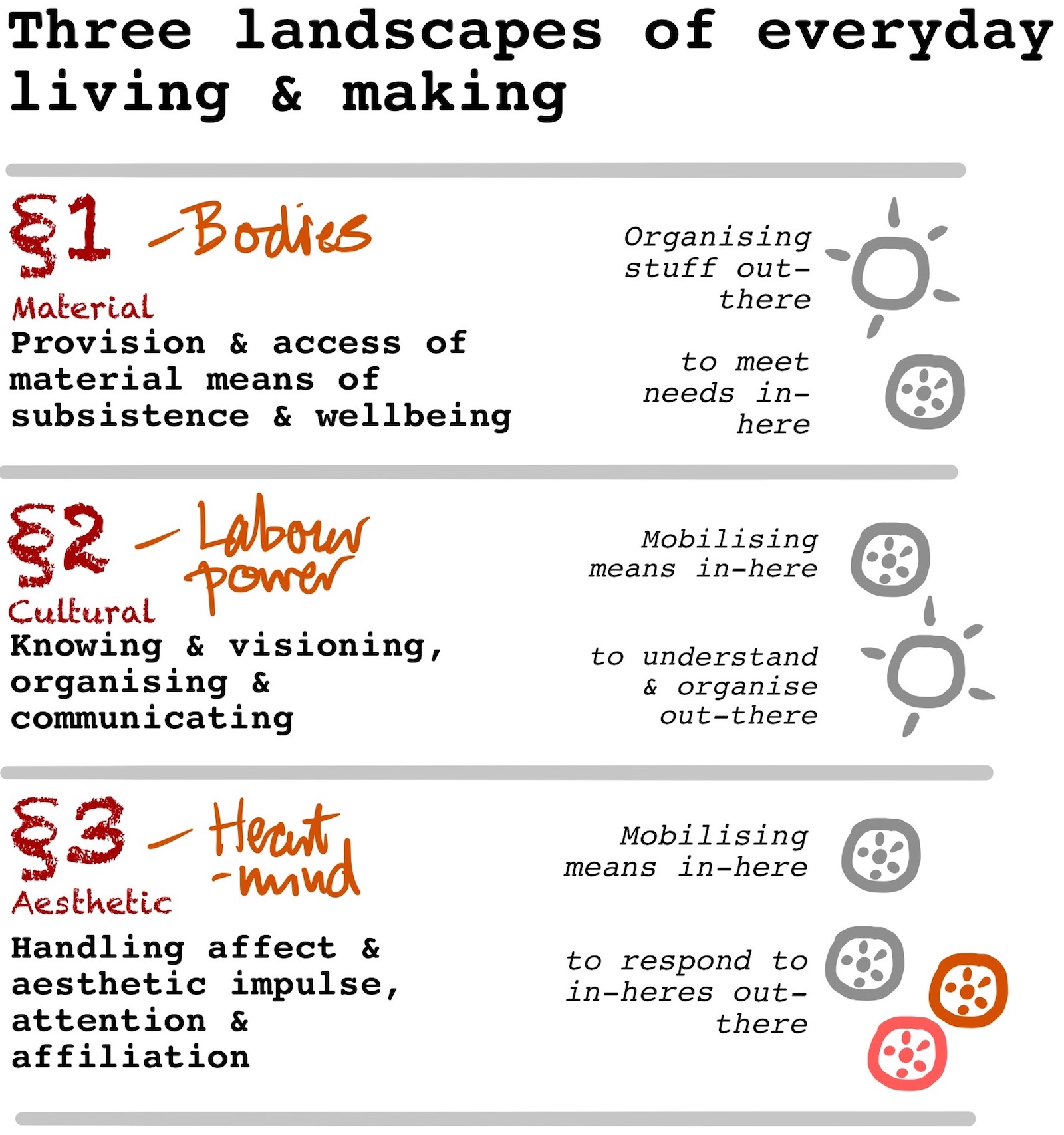Attending centrally to the body brings the central distinction - and relationship - between in-here and out-there. This has connections with the issue of structure and agency. But for foprop it is not a particular problem.
This is a branch of the foprop weave
Theorising with a language of ‘values’, a ‘social’ economy, aspirations to ’social’ usefulness, etc, is idealist. Wereas valu**ing**, socialis**ing**, aspiring, affiliating and so on are all entirely material practices, conducted (intentionally or casually, skilfully or sloppily, as the case may be) in particular locations and situations by persons and collectives; entirely material, too, to the making of a Living Economy.
They warrant a material(ist) theorising: a theorising **of practices**. This is a core, defining characteristic of foprop.
- **§1 Material** landscape - Engaging with the de facto, dynamic, evolving material organisation of the world **out-there** in meeting needs of people ‘in-here’ for material means of **subsistence and wellbeing**.
- **§2 Cultural** landscape - Mobilising the capability of people **‘in-here’**- (in the mind and in the body, individually and in collectives - in relation to challenges of **knowing and organising** the world out-there. The alignments and orientations of individuals in 'social bodies' - formations - constitutes culture as an inescapably material sphere, no matter how abstract, conceptual or imaginary the communicating and conceptualising being undertaken.
- **§3 Aesthetic-affective-impulsive** landscape - Responding skilfully, with careful intention, moment-to-moment, **in-here**, in a plurality of forceful and largely preconscious **in-heres**, both in here and out there . . all presenting in bodies. It doesn't get more material than this, the sphere of gut feel, of habit, of in-yer-face!
In the foprop weave, the §landscapes together address the material order of what is typically understood as ‘structure’ and **location**, while the ¿zones together - highlighting intention and perception, affiliation and reach - address the **situational** world of what is often addressed in terms of (problems of) ’agency’. The foprop weave
However, the dualism of structure/agency, and the implied 'problem of agency', is not one that runs deep in foprop.
Some of the material patterns that are most central - eg **in-the-body** patterns of affect and response in landscape §3 - are implicated in the most ‘subjective’ experience, as preconscious passes into potentially conscious and then into de facto enacted; where ‘agency’ arises and is largely determined: where the rubber hits the road.
Conversely, patterns in each landscape have ‘structure’ - **§1 forms**, **§2 formations** or **§3 forces** that are enduring and powerful - which constitutes durable ‘dramatis personae’ (human and non-human) in the field of what moves, and what determines outcome, in a system.
Thus, in the system-descriptions that are provided for each landscape in Weft - Three landscapes of material existence, one of the three standard elements of a description is the ’dramatis personae’ of the system; its enduring and prominent structure elements.
Even landscape §3, for all its continually flowing, arising-and-passing, experiential nature, has such forces, which are sometimes referred to for example by deliberately paradoxical terms like ‘structure of feeling’.
**The problem of agency**
‘The problem of agency’ has become prominent in recent generations alongside the rise of ’identity politics’ and the widespread recognition that ‘the personal is political’.
foprop engages with this significant historical set of conditions for activism through perspectives that range across all three §landscapes . . - Firstly, through attention to in-here forces and relations of **production-of-affiliation** (a constitutive aspect of landscape §3); and - Secondly through fundamental, persistenmt engagement in landscape §2 (‘cultural’ production) with **formations** - constellations of labour power - organised as an aspect of what ‘we’ as makers intend to do in the world: to make, to cultivate, to bring into being.
The materialist and historical concern with ‘cultural’ formations - especially, scale and durability - then necessarily turns (thirdly) to elements in landscape §1: notably tools, prostheses and material access to **infrastructures of means**.
It’s through the weave of constructs and patterns like these, across the landscapes and zones of the weave,that foprop addresses the problem of agency.
Fundamentally though, for foprop there is no ‘problem’ of agency. The foprop problem is - to **materially organise** - to create sufficiently durable, rich and extended **‘structures’** (infrastructures) - of artefacts, and formations of activists, and in-here forces of in-the-moment awareness (‘mental formations’: sankhara) - to conduct the actions of **curating, stewarding and enjoying of commons**, which the ‘agents’ - activists - recognise as being materially implicated in skilful responses to challenges: making the Living Economy, and engaging the needs of the grandchildren’s grandchildren.
The ‘problem’ is practical and historical, not philosophical. It is more a matter of cultivating and communicating **skill**, and skilfully-attuned perception and intention, than 'a problem' of achieving agency in the face of hugely extended structure in time and space.
--- Next: Affiliating & resonating
